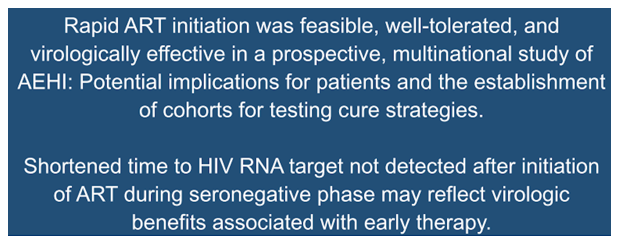 |
 |
 |
| |
FEASIBILITY AND VIRAL RESPONSE TO TREATING
ACUTE/EARLY HIV IN A MULTINATIONAL STUDY
|
| |
| |
CROI 2022 Feb 11-16

Eric S. Daar1, Justin Ritz2, Lu Zheng2, Jintanat Ananworanich3, Cecelia Kanyama4, Susan J. Little5, Susan E. Cohn6, Sharon A. Riddler7, Ann C. Collier8, Robert Coombs8, Lawrence Fox9, Javier R. Lama10, Trevor A. Crowell11, for for the AIDS Clinical Trials Group (ACTG) A5354 Study Team
1Harbor-UCLA Medical Center, Torrance, CA, United States, 2Harvard TH Chan School of Public Health, Boston, MA, United States, 3University of Amsterdam, Amsterdam, Netherlands, 4University of North Carolina Project, Lilongwe, Malawi, 5University of California San Diego, La Jolla, CA, United States, 6Northwestern University, Chicago, IL, United States, 7University of Pittsburgh, Pittsburgh, PA, United States, 8University of Washington, Seattle, WA, United States, 9National Institute of Allergy and Infectious Diseases, Bethesda, MD, United States, 10Asociacion Civil Impacta Salud y Educacion, Lima, Peru, 11US Military HIV Research Program, Silver Spring, MD, United States
Background:
Antiretroviral therapy (ART) initiated during acute and early HIV infection (AEHI) may limit reservoir size and facilitate post-ART control. ACTG A5354 is a prospective study designed to assess virologic and immunologic impact of ART during different stages of AEHI. We report the feasibility to rapidly identify, start ART and achieve viral suppression during AEHI in a multinational study.
Methods:
A5354 enrolled adults with AEHI at 30 sites in the Americas, Africa, and Southeast Asia. Participants were encouraged to start ART at presentation with suspected AEHI. Fiebig stage at ART initiation was retroactively assigned by centralized testing; categorized as Group 1 (Fiebig I/II), Group 2 (Fiebig III/IV) or Group 3 (Fiebig V).
Results:
From Jan 2017 to Dec 2019, 195 participants with suspected Fiebig I-V were enrolled and initiated ART. Three were found to not have HIV and four were Fiebig VI, and therefore not followed. Of 188 followed, 132 (70%) were from US and 56 (30%) from international sites. Fiebig stages I (n=6), II (n=43), III (n=56), IV (n=23), and V (n=60) with 72% screened and initiated treatment on same day. Integrase inhibitor-based ART was started by 98%. Enrollment characteristics were similar across Groups 1-3 (G1-3) with median age 27 (IQR 23, 38) years, 14% female, 96% cisgender, 54% African American/Black, 35% Hispanic with 36% hospitalized and 28% asymptomatic. Median (IQR) plasma HIV RNA in G1-3 were 6.4 (5.3, 7.0), 6.5 (6.0, 7.0) and 5.4 (5.0, 6.4) log10 copies/mL, respectively. Median (IQR) CD4 (cells/mm3) for G1-3 were 348 (211, 493), 383 (264, 507) and 490 (366, 652), respectively. Premature study discontinuation occurred in 16% of US and 17% of international participants. Over 72 weeks of follow-up, ART was held or switched in 34 (18%) participants and viral failure occurred in 4 (2%). Time to HIV RNA <50 copies/mL was similar across groups, but G1 was faster to RNA target not detected than G2 and G3, despite similar baseline HIV RNA (Figure).
Conclusion:
Rapid ART initiation was feasible, well-tolerated, and virologically effective in a prospective, multinational study of AEHI. Shortened time to HIV RNA target not detected after ART initiation during seronegative phase may suggest virologic benefits. This data demonstrates ability to conduct global projects designed to rapidly treat AEHI, as well as potential beneficial virologic effects of early ART. Additional analyses will assess impact of this strategy on viral reservoir and host immune responses.
|
| |
|
 |
 |
|
|